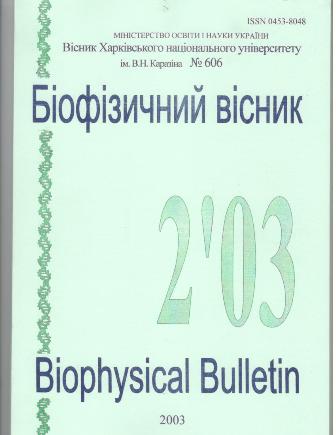Physical and mathematical axially symmetrical model of adsorptional endocytosis. II. Cell shape change during dehydration stage
Keywords:
endocytosis, physical and mathematical model, deformation free energy, membrane shape
Abstract
In this work on the principle of free energy minimum of cellular membrane bending deformation we calculated the change of cell shape in which protein domain formed during dehydration of the cell. The domain consists of molecules with great negative spontaneous curvature.
Downloads
Download data is not yet available.
References
Gordienko EA, Timofeeva EV. Fiziko-matematicheskaia osesimmetrichnaia model adsorbtcionnogo endotcitoza. 1. Uravneniia, opredeliaiushchie formu kletki. Biofizicheskii vestnik. 2002;1(10):58-61. (in Russian)
Gordienko EA, Timofeeva EV. Fizicheskaia model nespetcificheskogo endotcitoza. Biofizicheskii vestnik. 2003;1(12):79-85. (in Russian)
Gordienko EA, Timofeeva EV. Fizicheskaia model nespetcificheskogo endotcitoza. Biofizicheskii vestnik. 2003;1(12):79-85. (in Russian)
Published
2018-06-25
Cited
How to Cite
Timofeyeva, E. V., & Gordienko, E. A. (2018). Physical and mathematical axially symmetrical model of adsorptional endocytosis. II. Cell shape change during dehydration stage. Biophysical Bulletin, 2(13), 68-71. Retrieved from https://periodicals.karazin.ua/biophysvisnyk/article/view/12412
Section
Cell biophysics
Authors who publish with this journal agree to the following terms:
- Authors retain copyright and grant the journal right of first publication with the work simultaneously licensed under a Creative Commons Attribution License that allows others to share the work with an acknowledgement of the work's authorship and initial publication in this journal.
- Authors are able to enter into separate, additional contractual arrangements for the non-exclusive distribution of the journal's published version of the work (e.g., post it to an institutional repository or publish it in a book), with an acknowledgement of its initial publication in this journal.
- Authors are permitted and encouraged to post their work online (e.g., in institutional repositories or on their website) prior to and during the submission process, as it can lead to productive exchanges, as well as earlier and greater citation of published work (See The Effect of Open Access).





